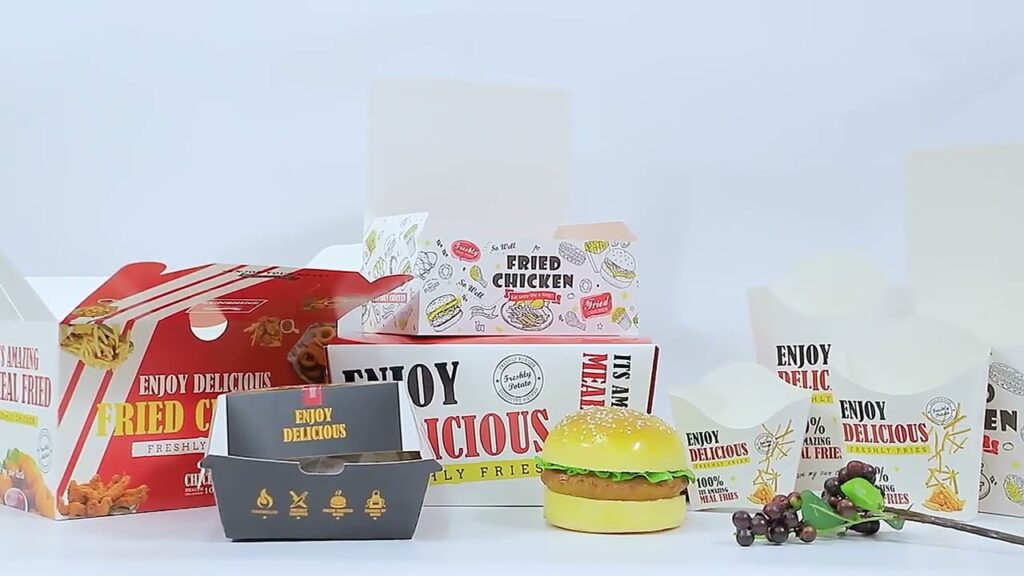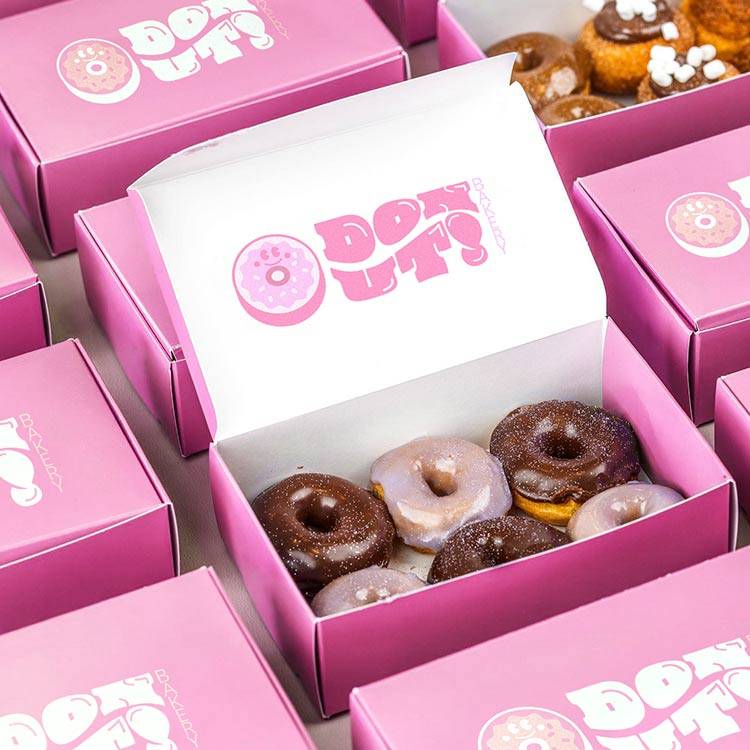Introduction

The packaging you choose for your food products is one of the most important decisions you’ll make. Not only does it protect and contain your items, but it also represents your brand and influences consumers. With so many options for food box packaging, how do you determine what’s best for your particular products? This comprehensive guide covers everything you need to know to select optimal food box packaging.
Table of Contents
Types of Food Box Packaging
There are several main categories of food box packaging to consider:
Folding Cartons
Folding cartons are constructed from paperboard that is folded and glued into shape. They come in different shapes like boxes, trays, sleeves, wraps, etc. Folding cartons are lightweight, recyclable, and customizable. They provide good protection and allow high-quality graphics. Common uses include cereal boxes, frozen food boxes, and beverage cartons.
Corrugated Boxes
Corrugated boxes are made of three layers – one interior fluted layer sandwiched between two flat outer layers. The rippled middle layer gives strength and cushioning. Corrugated boxes are sturdy, recyclable, and versatile. They are ideal for shipping and transporting products. Fruit, vegetables, bottled items, and packaged foods often use corrugated boxes.
Food Trays and Clamshells
Trays and clamshells are made of molded pulp, plastic, or other materials. They often have a flat bottom and surround walls to hold food securely. Trays/clamshells allow visibility, provide protection, and can be recycled or reusable. They’re commonly used for produce, bakery items, snacks, and takeout meals.
Paperboard Canisters
Canisters have a cylindrical shape constructed from paperboard. They may have slip-on lids or screw-top closures. Canisters effectively protect food, have good shelf presence, and keep contents fresh. Common paperboard canister uses include coffee, nuts, popcorn, spices, and other dry goods.
Other Options
There are many other food box packaging options like bags, pouches, tubes, cups, and wrappers. The best choice depends on your specific food item.
Factors to Consider
Several key factors should guide your choice of food box packaging:
Product Type and Characteristics
The type of food product and its characteristics will determine suitable packaging. Items that are fragile, perishable, or must stay fresh need sturdy, well-sealed boxes. Items that customers will view before purchase require transparent or display-worthy boxes.
Target Market
Consider your target demographic and what kind of packaging will appeal to them. For example, eco-conscious millennials may prefer recycled and minimalist options while baby boomers value nostalgic, retro-looking packaging.
Food Safety
Packaging must protect foods and comply with food safety regulations. Certain materials reduce food contamination risks. Ensure packaging provides adequate containment, protection from pests, temperature control, and maximum shelf life.
Brand Image
Your packaging conveys brand identity through shape, colors, graphics, and messaging. All elements should align with your desired brand image and positioning. The box style and design should represent your company’s values and personality.
Cost
Different packaging options have a wide range of associated costs for production and customization. Take costs into account but also consider value – more protective or functional packaging may be worth a higher investment.
Sustainability
Many consumers now favor eco-friendly packaging made from renewable, recyclable, or biodegradable materials. Sustainable options include plant-based bioplastics, recycled paper, and compostable boxes.
Choosing Food Box Packaging Materials
Once you’ve selected a box format, the next decision is what material it should be constructed from. Here are benefits and drawbacks of common food packaging materials:
| Material | Pros | Cons |
|---|---|---|
| Cardboard/Paperboard | Lightweight, recyclable, printable | Not moisture-resistant |
| Plastic | Durable, transparent, reusable, recyclable | Produced from fossil fuels |
| Aluminum | Impermeable to light, gases, and bacteria | Non-biodegradable, high carbon footprint |
| Glass | Impermeable, reusable | Heavy, fragile, high carbon footprint |
| Bioplastics | Made from plants, compostable | Limited availability, can be pricey |
Consider tradeoffs like protection versus environmental impact and cost versus product visibility. Often, a combination of materials is optimal – like a cardboard box with a plastic liner or window.
Customizing Your Food Packaging

Once you select the packaging type and material, it’s time for customization! You can tailor boxes with:
- Shape and dimensions: Match the box size and form to your products. Consider standard versus custom shapes.
- Graphics and branding: Add colors, patterns, logos, typography, and images that represent your brand. Consider matte versus glossy finishes.
- Opening and closing: Choose box openings, closures, handles, and tabs to improve access and usability.
- Inserts: Include protective inserts like padding, partition walls, and trays to separate and cushion products.
- Special coatings: Coatings can add properties like water resistance, insulation, or reusability.
- Labels and messaging: Add product information, health claims, certifications, and preparation instructions.
- Sustainability: Use renewable materials, soy-based inks, or recyclable components.
Work closely with your packaging designer and manufacturer to create food boxes aligned to your brand and product needs. Ask for samples to view and test different options.
Choosing a Packaging Supplier
The final key step is choosing the right supplier to produce your custom food packaging. Here are tips for selecting a food box manufacturer:
- Review their industry experience, especially with similar products to yours
- Ask about their production capabilities and minimum order quantities
- Request samples of their work and check print quality
- Inquire about materials sourced and sustainability practices
- Compare pricing and services like design, storage, and shipping
- Check that they meet food safety and regulatory requirements
- Look for responsive customer service and project management
- Seek suppliers willing to partner and adapt as your business grows
Conclusion
Finding the optimal food box packaging takes research and strategic thinking. Defining your priorities upfront in terms of target audience, food type, brand image, cost, and sustainability helps narrow the choices. Testing samples and procuring quotes from a few suppliers gives helpful data points. While it takes effort to select suitable food packaging, the end result is elevated, protected products that represent your brand well and appeal to consumers. With sound choices, your food box packaging can differentiate your offerings and propel business success.
FAQ
What are the most protective food box packaging options?
For highly fragile or perishable foods, sturdy corrugated cardboard or molded pulp containers provide the most protection. Multi-layered boxes with cushioning inserts or insulation also help shield food from damage.
How do I determine the optimal size and shape of packaging?
Consider the size and form of your actual food products. The packaging interior should fit them neatly without excess empty space. Standard box sizes are available, or fully custom boxes can be made. Balance portability with maximizing space efficiency.
What printing options are available for custom food packaging?
From simple spot colors to sophisticated photographic prints, many options exist. Printing choices include flexography, lithography, digital printing, and more. Discuss the capabilities and minimums with your box manufacturer.
Does packaging need to list food ingredients and nutritional information?
Foods intended for direct retail sale generally must comply with labeling regulations. Requirements vary by country but often include ingredients, allergens, nutrition facts, manufacturer details, safe handling instructions, and more.
How do I order custom printed box packaging cost effectively?
Ordering larger quantities gets a better per unit price but increases minimum orders. Reduce costs by keeping design simple and using standard sizes and materials. Talk to your supplier about optimizing the balance between customization and affordability.
